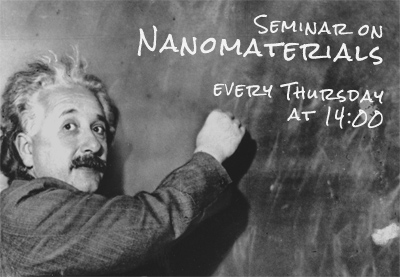Nanoseminar
Group of Structure analysis at the Department of Condensed Matter Physics
of Charles University and MGML has a pleasure to invite you to attend the seminar on nanomaterials: Physics, Technology, Applications
on 23rd November 2023 at 14:00
at Faculty of Mathematics and Physics of Charles University, Ke Karlovu 5, 121 16 Praha 2
Lecture room F2
Ing. Dominik Legut, Ph.D.
DCMP Charles University and Technical University of Ostrava
Polar bonding, correlations, magnetism and lattice dynamics in uranium hydrides
Ing. Dominik Legut, Ph.D. » Polar bonding, correlations, magnetism and lattice dynamics in uranium hydrides
DCMP Charles University and Technical University of Ostrava
Online link: cuni-cz.zoom.us Ask M. Dopita for password.
Location: F2, Ke Karlovu 5 [joint with seminar of Condensed Matter Theory]
Hydrides of actinides, their magnetic, electronic, transport, and thermodynamic properties are discussed within a general framework of H impact on bonding, characterized by volume expansion, affecting mainly the 5f states, and a charge transfer towards H, which influences mostly the 6d and 7s states. These general mechanisms have diverse impact on individual actinides, depending on the degree of localization of their 5f states.[1] Hydrogenation of uranium yields UH2 and UH3, binary hydrides that are strongly magnetic due to the 5f band narrowing and reduction of the 5f -6d hybridization. In this talk we have analyzed the electronic correlations and the polar bonding in uranium hydrides including the magnetic interactions for UH2, as well as in alpha and beta phases of UH3. We enlightened the origin of the non-collinear magnetism of one of the uranium Wyckoff position as well as the breakage of the Hill's limit. The calculated Curie temperatures for all hydrides are in good agreement with the experimental data. Our results give predictions of elastic coefficients (consistent with the known bulk modulus in the case of β-UH3) and phonon densities of states, yielding expected infrared, Raman, and Hyper Raman active modes[2]. Further we analyze the stability of the doped UH3 phases by transition metals and its inluence on the size of the spin and orbital moment in order to correlate with the increase of TC for some dopants.
The work was published in [1-3] and acknowledges project e-INFRA CZ (ID:90140) by the the Ministry of Education, Youth and Sports of the Czech Republic.
[1] L. Havela, D. Legut, and J. Kolorenč, Rep. Prog. Phys. 86, 056501 (2023).
[2] L. Kývala , L. Havela , A.P. Kadzielawa , and D. Legut, J. of Nucl. Materials 567, 153817 (2022).


